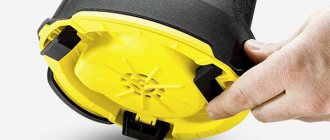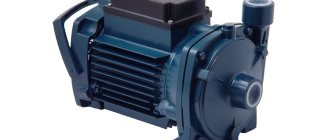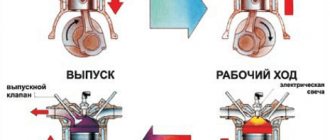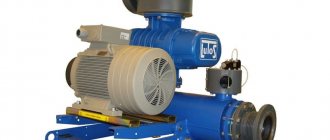In various spheres of human activity, the creation of a vacuum is required. This term characterizes the state of the gas phase, the pressure of which is below atmospheric. It is measured in millimeters of mercury or pascals. Rarefaction of gases occurs when a substance is forcibly removed from devices having a limited volume. A technical device designed for these purposes is called a vacuum pump. It can be used independently or included in more complex systems.
Vacuum pumps and their features
There are many specialized devices in the world designed to create vacuum. The most popular of them are vacuum pumps. All these units can be divided into the following types :
- Vacuum units;
- Vacuum pumps;
- Vacuum installations.
The main task of these devices is to pump out air, gases of various types and water, steam-gas mixtures and similar substances. In industry, the most popular devices are vacuum pumps of various types. They all have one thing in common - pumping occurs very quickly. The operating speed of vacuum pumps depends on their technical parameters.
Boost pump for a summer residence: what are they?
This is a small device that increases existing low blood pressure. That is, they cannot create it from scratch. This device crashes into an existing water supply system and pumps up water, raising the pressure by 1-3 atm. There are several types of pressure booster pumps:
- By type of cooling: with a dry rotor - they have a higher efficiency, but are noisier and have larger sizes;
- with a wet rotor - the noise level is low, the dimensions are small, but not very effective, although they can cope 100% with increasing pressure in the country water supply (and not only).
- manual activation - when you need to increase the pressure, turn it on, if not necessary, turn it off; not very convenient: you need to make sure that the pump does not overheat;
- horizontally;
- single-stage - have one pumping speed;
- in-line - compact but low-performance models built into the supply pipeline;
Read here how to bring water into your house from a well.
How to choose
To avoid too much confusion, a booster pump for water supply in a country house is usually taken in-line (built-in) with a wet rotor. This is the best option for a summer residence: little noise, ease of installation.
The type of installation - vertical or horizontal - depends on the place in which you will install it. Regarding speeds, multi-stage adjustment is, of course, better, but such pumps cost a lot, so they are rarely installed in country water supply systems.
You can also pay attention to the material of the case. It can be made of cast iron or stainless steel. Stainless steel is naturally better, but also more expensive. You need to pay attention to the material from which the pump impeller is made. In the cheapest models it can be made of plastic, in more expensive ones it can be made of bronze or brass.
Vortex pump for increasing pressure in the country
Operating principle of vacuum pumps
All vacuum pumps operate on the same main principle, displacement. When a substance is pumped out with a vacuum pump, the volume of the working chamber changes. The design of a liquid ring type vacuum pump is as follows :
- The shape of an industrial pump is usually cylindrical;
- Inside the working chamber there is a specific shaft with a wheel called an impeller. This unit is a key part of the entire unit;
- The wheel, when rotating in the body of the device, captures water with its blades, resulting in a centrifugal force that causes water to spread along the walls of the working chamber;
- A specific water ring is formed from the working fluid, and a vacuum is formed inside.
After the pump is started, it will begin to draw in air or gas, and then send the purified flows in the desired direction.
Rotary vane type vacuum pumps operate according to a different scheme, since their design is different. A vacuum pump of this type consists of the following components :
- Housings;
- Entry and exit;
- Blades;
- Special rotor.
The exhaust valve is equipped with an oil seal. The rotor blades divide the working chamber into two compartments. When the pump is turned on, gas will begin to flow into the expansion chamber.
Operating principle of the equipment
Inside the pump there are several parts that carry out sequential movements. First of all, the crankshaft drive begins to work, which is activated together with the connecting elements and forces the cylinder piston to move along the vertical axis. When it reaches the lowest point, the suction port opens and the gas begins to compress. When the piston begins to move upward, the suction port closes. When the required pressure is created, the valve plate opens. Thanks to this process, the gaseous medium is redirected through the suction port to the second stage. Next, the gas medium passes through the bypass valve and ends up in the crankshaft housing. Thanks to a special seal, the intake channel does not come into contact with the crankshaft during compression. After this, the 2nd stage of pumping the working medium begins. The gas enters the atmosphere according to a similar pattern that was described earlier.
It is worth noting that piston vacuum pumps have a very significant advantage. Thanks to the additional check valve, the gaseous medium passed through the system is not able to return to the working chamber. Also, systems of this type are equipped with safety valves, which reduce to zero the risk of air breakthrough in the event that the supply of the necessary power supply suddenly stops.
Operating principle of the equipment
Vacuum pump, application area
The advent of vacuum pumps has made it possible to simplify various technological processes that require a vacuum environment. Vacuum pumps are used in the following industries :
- Protect the environment. This is an extremely broad area, since many industries have special treatment facilities and containers that purify the breakdown products of harmful substances;
- Printing production. Vacuum pumps of various types are used to prepare, copy and scan images;
- In the food industry, the demand for vacuum pumps is extremely high. They are used for processing and vacuum packaging of various products;
- In the medical industry. Mini-vacuum devices are especially popular in medicine;
- In the chemical industry, vacuum pumps for the distillation of substances and decomposition products are in great demand. Many processes in the modern chemical industry cannot be imagined without the use of vacuum systems;
- Vacuum containers are often used in glass and ceramics production;
- Woodworking industry.
In addition to industry, vacuum pumps are used in agriculture, and even in everyday life.
How is the pumping station constructed?
To organize an autonomous water supply to a house from a well or borehole, it is worth purchasing additional elements and combining them into a full-fledged pumping station. In addition to the pump, you will need a hydraulic tank, as well as a pressure switch. This relay turns the pump on and off, depending on whether the hydraulic tank is empty or full.
The diagram demonstrates a detailed procedure for supplying water to a private house from a well using a surface pump as part of a pumping station
As a result, there will always be a certain supply of water in the house, and running the pump idle is completely eliminated. This significantly extends its service life. In addition, the presence of a hydraulic tank compensates for possible water hammer, which has a positive effect on the condition of the water supply system as a whole.
Additionally, it is also recommended to purchase a pressure gauge (if the hydraulic tank is not equipped with one). Of course, you can purchase a pumping station equipped with all the necessary components. The installation procedure for an industrially produced station and a self-assembled one are not too different.
Surface pumps are often used as part of a pumping station together with a hydraulic accumulator and a pressure switch, which automates the operation of this set of devices
A hydraulic accumulator or hydraulic tank is a container equipped with a special rubber membrane. As the tank fills, this membrane stretches, and when it is empty, it contracts. Such a device is considered highly effective for autonomous water supply.
Vacuum water pumps and their characteristics
Water vacuum pumps are extremely popular in industry. They are durable, easy to maintain and have a wide range of capabilities. The main technical characteristics of vacuum pumps of this type are as follows :
- The pumping speed depends on the power of the vacuum pump motor. Most modern models are capable of providing pumping speeds from 1.1 m3 per minute to 12 or more m3 per minute;
- The motor power of vacuum water pumps varies from 4 to 40 kW, although more powerful motors are also available;
- The dimensions of vacuum pumps depend on the performance of the units;
- The average weight of pumps of this type starts from 25 kg and ends at 2,000 kg. Although there are also heavier pumps.
Now vacuum water pumps are widely represented on the vacuum equipment market. Many domestic and foreign manufacturers offer their equipment with various characteristics and purposes. Domestic pumps are able to compete with foreign analogues. Thanks to the simplicity of design, durability and high-quality body materials, they can be used in the most difficult conditions and in any industrial and commercial areas.
Application Notes
Oil-free piston pumps have higher pumping speeds than diaphragm pumps and are designed to operate in pure, hydrocarbon-free vacuum conditions at near-limit pressure. By removing the inlet valve, it is possible to achieve a lower base pressure compared to diaphragm pumps. Like all positive displacement pumps, piston pumps provide the same pumping speed for all gases.
Piston pumps are suitable for use as foreline pumps for turbomolecular pumps. However, to avoid the concentration of hydrogen and water vapor in the fore-vacuum zone of the turbopump, gas ballast should be used if necessary. Piston pumps are particularly well suited for use in analytical and leak detector applications. Helium leak detector device). If control samples are directly pumped by a foreline pump to detect leaks, then when using an oil-free foreline pump they will not become contaminated with oil vapors.
Piston pumps are not suitable for pumping corrosive and abrasive media.
Application area
Can be used as a stand-alone pump in all medium vacuum applications
Analytical systems
- Mass spectrometers
- Leak detectors
- Electron microscopes
Other Applications
- Robotics (control systems)
- Differential sealing systems
- Vacuum packaging
and also as a foreline pump for high-vacuum pumps such as Pfeiffer Vacuum turbopumps.
Vacuum pump installation
Installing a vacuum unit is not difficult, but you must strictly follow the recommendations in the product data sheet. The basic requirements when installing a vacuum pump are as follows :
- The pump is installed in the driest and cleanest place available in the room;
- The vacuum pump must be installed on a foundation, the mass of which must exceed the mass of the pump by at least 2-3 times;
- The location for the vacuum pump must have open access for various types of work;
- The air temperature in the room where vacuum equipment is installed should be within +5-40 degrees Celsius;
- The unit must be installed horizontally, and there must be a gap between the supporting surface of the pump and the base. All mounting bolts must be tightened until they stop. If this requirement is neglected, the pump will vibrate during operation, which can lead to breakdowns and increased noise levels during operation.
A properly installed vacuum pump will work for a long time without breakdowns. Despite this, visual inspection of vacuum equipment should be carried out daily. Particular attention is paid to the mounting bolts; if they are loose, they must be tightened.
Roots pump design
The operating principle of a rotary vacuum pump was described above, but you can find information about its design in this section. The pumps mentioned can be classified as displacement rotary vacuum pumps that operate dry. Among the main components of the equipment, the following should be highlighted:
- engine;
- exhaust pipe;
- labyrinth seals;
- bypass valve;
- oil level indicator;
- fixed bearing;
- free bearing;
- suction chamber;
- oil drain;
- exhaust channel.
The rotor shaft bearings are located on two side surfaces. In order to ensure uneven thermal expansion between the piston and the housing, they are designed as fixed bearings and seal inner rings on different sides. The bearings are treated with oil, which is pumped from the mudguards. The drive shaft is brought out and insulated with radiator shaft rings.
The rings are made of fluorine rubber and are then lubricated with sealing oil. The rings located on the sleeve are necessary to protect the shaft; by the way, they can be replaced if necessary. If a hermetic seal is required from the outside, the equipment can be driven using a coupling with a cup and magnets.
Purpose of indicators
| "Nutrition" | control unit power is on; |
| "Vacuuming" | the electric drive is turned on, the vane pump rotates; |
| "Pump is full" | the fire pump is completely filled with water, the fill sensor has triggered; |
| "Not the norm" | one of the system malfunctions was recorded: 1) the time of continuous operation of the electric motor exceeded 50... 55 seconds. Short flashes of the indicator alternate with longer ones; 2) the contacts of the traction relay are burnt, the engine does not start. The indicator flashes evenly; 3) the electric motor is overloaded (the vane pump is blocked by frozen water or foreign objects). The indicator blinks evenly. |
Performance characteristics
Table No. 1
| Name of parameters | Meaning |
| Control method | semi-automatic or manual |
| Rated supply voltage, V | 12 |
| Current consumption, A | 130… 160 |
| Maximum vacuum, kgf/cm2, not less | 0,8 |
| Fire pump water filling time, s, no more: – from a height of 3.5 m – from a height of 7.5 m | 2040 |
| Continuous operation time, s, no more | 60 |
| Type of vacuum unit overload protection device | Automatic, electronic |
| Average oil consumption (motor oil according to GOST 10541) per operating cycle, ml | 5 |
| Overall dimensions of the vacuum unit, mm, no more: | 400 x 220 x 220 |
| Overall dimensions of the control unit, mm, no more: | 150 x 140 x 75 |
| Product weight (total), kg, no more | 25 |











